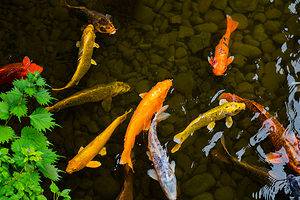Are you familiar with koi fish? This hardy fish is definitely famous – it has been enchanting hearts for hundreds of years. Koi fish are the colored variety of the Amur Carp (Cyprinus rubrofuscus), and they carry a lot of symbolism, especially in Japanese culture. Why are they important to you? You might have seen plenty of art and symbolism revolving around this beautiful fish, or you might own one or more of your own. Are you curious about the history and meaning of this vibrant animal? We’re going to explain the importance of the koi in this article, along with taking a look at its habits and habitats, its diet, and the significance of the fish in various cultures.
What is a Koi Fish?
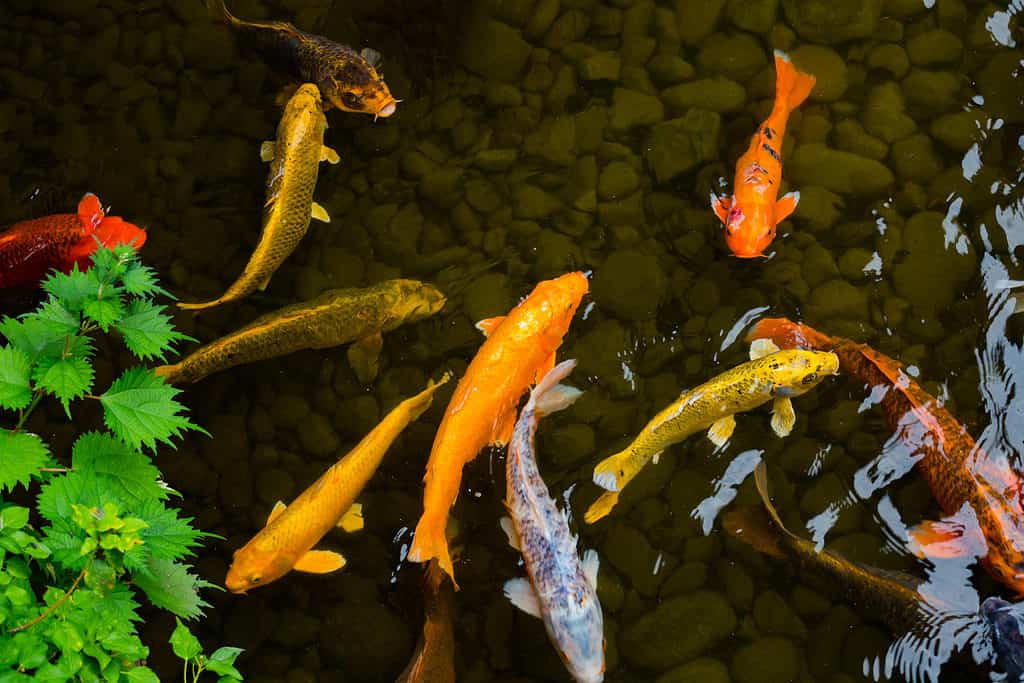
This ornamental carp grows up to 35 pounds in adulthood and boasts a variety of colors.
©glory_yabe/Shutterstock.com
A koi fish is a species of carp that is native to Central Europe and Asia. It is a coldwater fish that can easily adapt to a number of climates. However, the perfect temperature range for it is actually 59-77 degrees Fahrenheit. Koi are freshwater fish. As for size, koi reach a maximum length of about 36 inches in adulthood. They grow at a rate of 0.8 inches per month, so it doesn’t take long to see growth in young koi. This ornamental carp grows up to 35 pounds in adulthood and boasts a variety of colors, such as white, black, red, and yellow. Over 100 varieties of koi exist as a result of breeding.
Koi also have an impressive lifespan. The average koi fish lives about 47 years. This longevity contributes to their significance in many ways. One such example is this: In Japan, koi fish serve as heirloom gifts. This means that some Japanese families pass koi fish down through generations. Can you imagine inheriting the family fish?
Koi Diet
Koi are omnivores and not very picky about their diet. They prefer foods such as algae, insects, and worms, but they can and will also eat human foods such as lettuce, cereal, shrimp, and chopped vegetables. Some people even feed their koi watermelon! You can see that koi are quite indiscriminate – they’ll really eat any food that ends up in their waters. Even though they aren’t picky, it’s important to monitor what your koi is eating. Certain diets are simply more suited to koi than others and help promote immune health and vibrant colors.
An important thing to know is that koi don’t have teeth. Instead, they are “benthic feeders.” This means that they use the strong suction of their mouths to ingest food. Koi have a round, fleshy mouth that is perfect for bottom-feeding. They sort the nutrients from the sediment, which helps keep their waters clean and provides them with food.
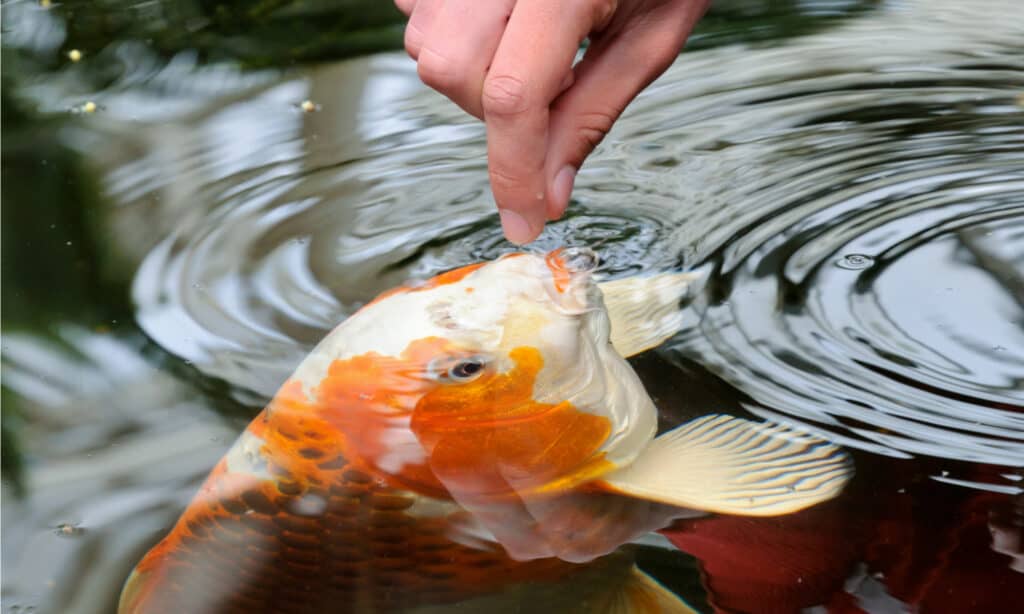
Koi are omnivores and not very picky about their diet.
©Paul van den Berg/Shutterstock.com
Early History of the Koi Fish
Koi fish history is actually quite extensive. It dates back over 2,000 years to China and begins with koi as a food source. Yes, you read that correctly – the living jewels of today’s decorative ponds were once just a meat source. Let’s explain that further and take a look at how this colorful carp became the fish it is today.
First, let’s focus on one key point: The koi that we know today are dominantly Japanese koi variations. While selective breeding of koi dates back further than the 19th century, this was the time that they became prominent for their colors. However, the first recorded mention of the colors of koi occurred around 265-316 A.D., and fossils of carp in southern China date back at least 20 million years. In the first writing about koi, the author details colors of red, white, black, and blue. The first use of the word ‘Koi’ to describe this fish dates back to around 2,500 years ago!
History of Koi in Japan
Carp has been used as food for a long time. Koi are a carp variety, so it makes sense that they would also be a food source. The consumption of carp increased in popularity for a long time, which led workers in Japanese rice bogs to begin raising them as a food source. This is when things began to change.
The rice bog farmers who were raising carp for food began noticing color mutations in their koi somewhere around the 1820s. The colorful fish stopped being just a food source as some farmers began taking the most colorful of the fish and keeping them as pets. The color mutations were a result of cross-breeding, and these Japanese farmers started taking note. This began the era of breeding koi for aesthetic appeal. These Japanese farmers called the fish “Nishikigoi,” which means “brocaded carp.”
As rice farmers continued to breed these fish for their color mutations, word got around and they developed more popularity. The true beginning of the koi’s popularity as a decorative fish began around 1914 when Emperor Hirohito was gifted with one of these colorful jewels.
Since then, a love of these vibrant fish has spread worldwide.
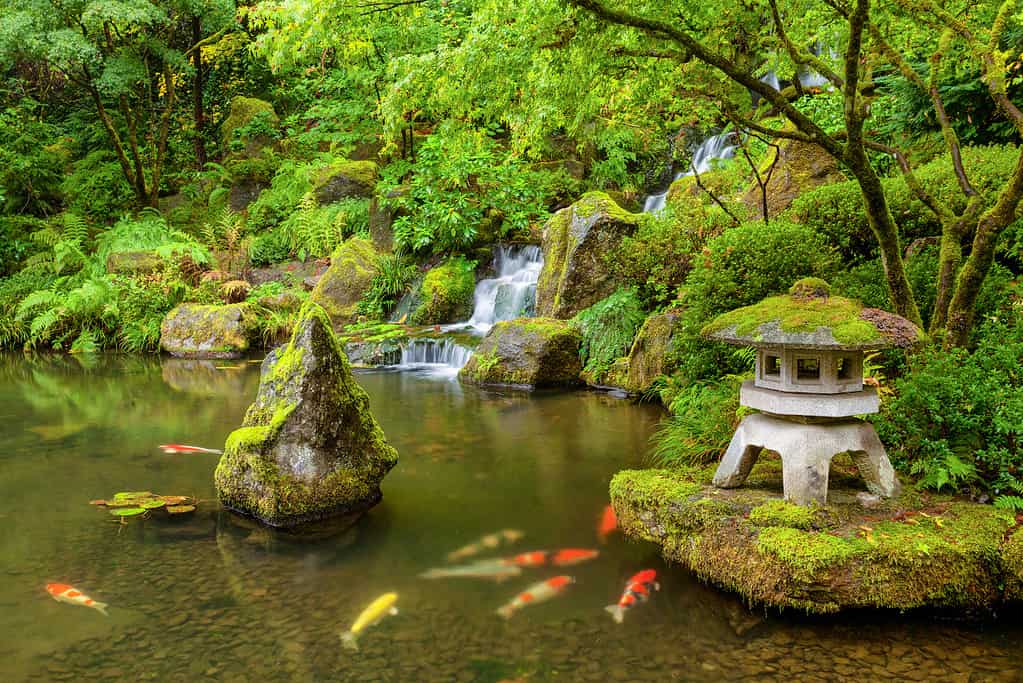
The koi that we know today are dominantly Japanese koi variations.
©paulacobleigh/ via Getty Images

Significance of Koi Colors
The colors of koi have specific significance and meaning. We’ll go through a few of the color variations and what they mean now. Since koi are celebrated and revered across several cultures, many of them have several meanings. We’ll go over six patterns that occur in this fish and what they symbolize.
| Name | Color/Pattern | Meaning |
|---|---|---|
| Yamabuki | Gold, sometimes with small red spots and white-tipped fins. | Riches and wealth |
| Kohaku | White color with red or orange patches. | Success and prosperity |
| Kuchibeni | White and red, with red coloring around its mouth. | Love and long-lasting relationships |
| Kumonryu | Two variations: a white body with black spots and an all black body. | Transformation, life changes |
| Ogon | Solid silver | Success in business and wealth |
| Asagi | Pale blue on the body with white reticulation. White head, fins, and tail with red or orange spots. | Prosperity and strength |
Along with singular significance, koi are spiritually significant overall. Many cultures revere them as symbols of luck, tenacity, courage, and abundance.
Other Significance and Symbolism
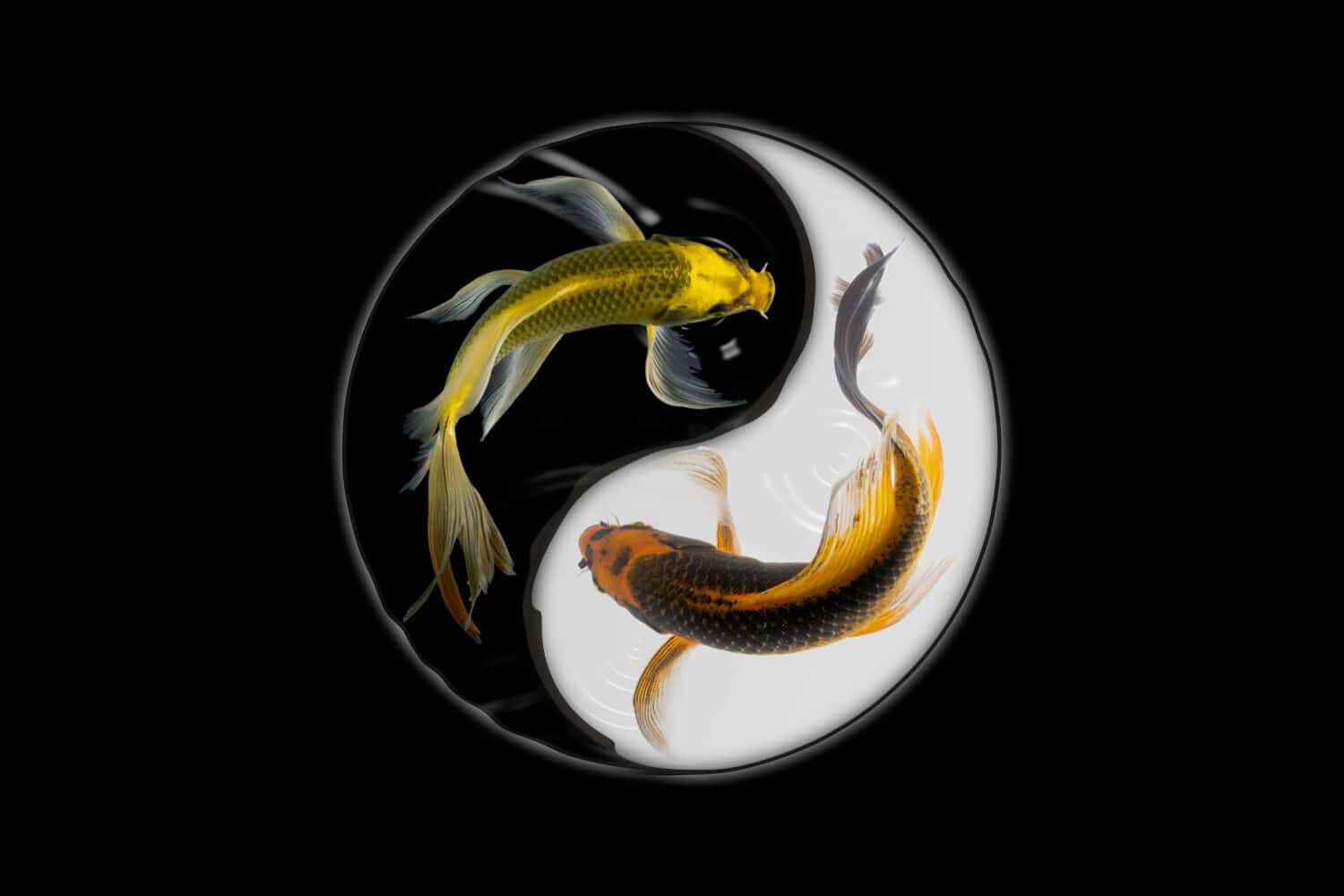
Koi are used in some depictions of the Yin-Yang.
©koifish/Shutterstock.com
Koi are used in some depictions of the Yin-Yang. The Yin and Yang are used to represent opposing but interconnected forces, or opposites that are tied together. Some examples of this are light and dark, creation and destruction, life and death, and peace and war. Each side of the symbol has a little bit of the other in it. One cannot exist without the other, and this creates life’s balance – a smooth flow of energy that exists in perfect exchange. When koi are used in representations of the Yin and Yang, there is added meaning.
Two koi together is a symbol of love. They represent balance and happy relationships. So, when a pair of these fish is added to the Yin and Yang, it becomes a powerful message of strength and balance in relationships.
Koi also represent strength and patience. One Chinese legend about these colorful carp showcases some of these qualities.
The story tells of a giant golden koi that swims up the Yellow River. The fish swims with an entire school of its brethren, but most of them turn around and swim back downstream when they reach a giant waterfall. The ones that kept trying faced a greater challenge – demons that watched from the cliffs near the falls. The demons made the waterfall taller in a malicious mockery of the efforts the fish were making. Finally, only one fish continued to try. This giant koi spent 100 years trying to swim up the waterfall before finally succeeding. When it made it to the top, the gods were impressed. They turned this giant golden hero into an even larger golden dragon. Because of this, the mighty fish is now seen as a symbol of perseverance.
Koi in Art
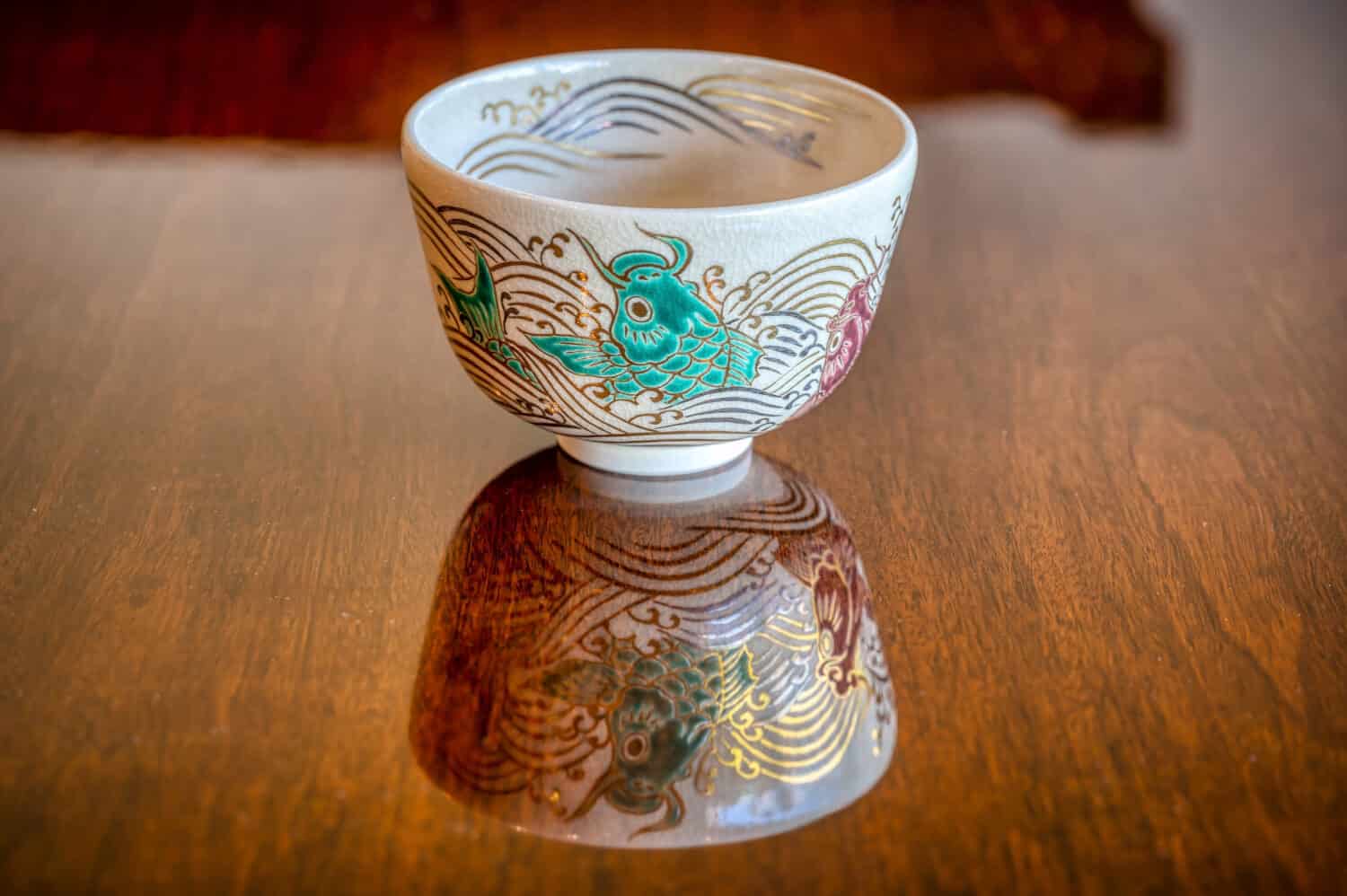
This Japanese teacup, adorned with carp leaping from golden waves, is used in tea ceremonies.
©PAUL ATKINSON/Shutterstock.com
Even now, depictions of koi are popular. Paintings of these colorful fish often represent abundance and positive energy in Chinese culture. We can take a look at older art and explore newer interpretations of koi in the artistic world.
An 1842 depiction of one of these fish by Japanese artist Keisai Eisen showcases the historical beauty and appreciation of the fish.
Japanese tradition continues to tie their version of the waterfall myth into their art. A depiction of a koi swimming upstream is one that represents determination. The fish is still on its path to achieving its dreams. Inversely, one of these carp swimming downstream actually represents wealth and prosperity. The fish has finished its life’s quest and is now enjoying the ride down the river on the currents of its success. Additionally, Japan admires art like this and believes it represents luck and good fortune.
Gyotaku Fish Prints
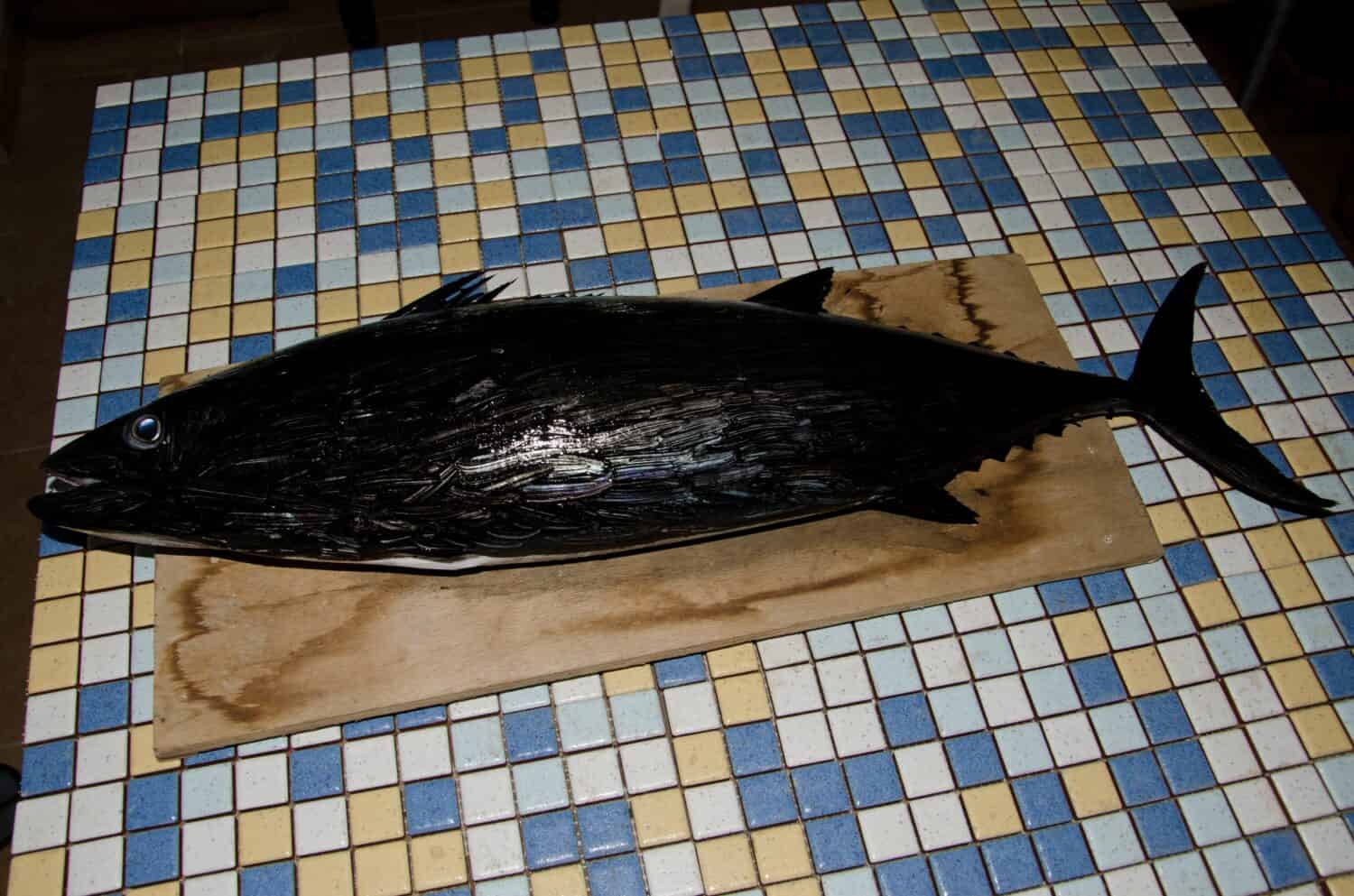
Traditional Gyotaku: an Atlantic bonito is painted black in preparation for its body to be printed on paper.
©Victor Suarez Naranjo/Shutterstock.com
In the 1800s, Japanese fishermen needed a way to document the size of their catch so they could share it. They would take the live fish, rub one side of it in ink, and then make an imprint of it on paper. This practice ended up very popular as an art form and all sorts of varieties of fish were used to make these impressions. Historically, an important aspect of the art print is actually the movement of the live fish. Now, artists are more likely to use rubber stamps to make the print. But carp, and especially koi, were frequently used in the art form.
Koi Tattoos
Now that the koi has become such a powerful image across the world, it makes sense that it would become a popular tattoo theme. Many of these tattoos are based on Chinese and Japanese traditional art but also carry personal meaning for the people getting the tattoo. Different colors are selected for koi tattoos to represent different meanings. Black koi tattoos often represent strength, while pink koi might represent femininity or motherhood and blue could mean tranquility and peace.
These tattoos are often paired with waterfall backgrounds or with a variety of flowers. A koi posed with a peony might represent good fortune, while one that is tattooed alongside a lotus may actually symbolize beauty and joy through hardship and adversity.
The lotus paired with the koi is an incredibly powerful message. Since lotuses carry so much significance, their presence alongside the colorful carp bears intense meaning. A lotus flower represents purity, harmony, truth, and faith. This symbolism paired with the strength, fortune, connection, and perseverance of the koi carries a lot of spiritualism for many people.
The photo featured at the top of this post is © iStock.com/coffeekai
Thank you for reading! Have some feedback for us? Contact the AZ Animals editorial team.




